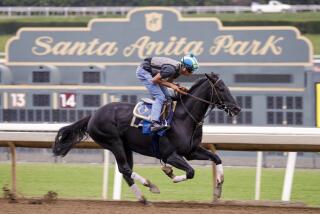Looping wooden roller coasters are about to become a reality
The first volleys of the next roller coaster revolution have been fired in the forested Idaho panhandle, the emerging epicenter of thrill ride innovation.
Located in the small town of Hayden, Idaho, Rocky Mountain Construction has burst onto the ride manufacturing scene seemingly out of nowhere, shaking the theme park industry like a rumbling coaster train rocketing along a rickety old track with plans to build two looping wooden coasters in 2013.
> Photos: Rocky Mountain and the history of looping wooden coasters
Not since the coaster wars of the 1980s and ‘90s have the possibilities for thrill rides, new and revamped, seemed so promising.
“It’s a huge breakthrough,” said Rocky Mountain owner Fred Grubb. “We’re barely tapping what we can and can’t do.”
A carpenter and welder by trade, the 53-year-old Grubb got his start in the ride manufacturing business in the 1980s as the in-house coaster maker for Idaho’s Silverwood Theme Park, building Tremors and Timber Terror with Custom Coasters International. In 2006, Grubb teamed with Intamin on El Toro, an award-winning wooden coaster with a prefabricated track at Six Flags Great Adventure in New Jersey.
But it wasn’t until last year that Rocky Mountain roared into coaster consciousness with it’s groundbreaking work restoring and rethinking the 1990 Texas Giant wooden coaster at Six Flags Over Texas, awarded the Golden Ticket award by Amusement Today as the best new ride of 2011.
Then came announcements that caused the jaws of coaster enthusiasts to drop, with Rocky Mountain unveiling plans to add a barrel roll to the 1992 Rattler wooden coaster at Six Flags Fiesta Texas and to build the triple-inversion Outlaw Run wooden coaster at Missouri’s Silver Dollar City.
Now the phone is ringing off the hook in tiny Hayden, Idaho.
“We have plenty of work,” Grubb said. “Our docket’s full. We’ll probably continue to expand.”
> Photos: Outlaw Run at Silver Dollar City | Iron Rattler at Six Flags Fiesta Texas
A looping wooden coaster has been the Holy Grail of coaster fans for decades, who had their hopes dashed when Kings Island built the Son of Beast wooden terrain coaster in 2000 only to remove the vertical loop a few years later. After a series of injury accidents, the Ohio amusement park has begun tearing down the ride entirely after letting it sit idle since 2009.
Rocky Mountain stepped into the void with the introduction of a hybrid coaster design that combines a steel track with a wooden structure that has enlivened a genre-bending debate about whether to call the revolutionary new ride a wooden or steel coaster.
“I don’t consider Iron Rattler or New Texas Giant to be wooden coasters,” said Duane Marden, who runs the venerable Roller Coaster DataBase website. “They could be called hybrid or steel, but definitely not wood. Outlaw Run is closer to a wooden coaster.”
Indeed, Amusement Today just named New Texas Giant the fifth best “steel” coaster in the world.
Robb Alvey, who runs the Theme Park Review fan site, answers the “Is it wood or steel?” debate with another question: “Does it matter?”
Alvey calls the New Texas Giant “fantastic” and describes anticipation for Iron Rattler and Outlaw Run as “through the roof.”
A Theme Park Review trip in August to all three of the Rocky Mountain coasters is already racking up reservations.
“Whatever those guys at Rocky Mountain are doing, they are doing it right,” Alvey said. “Two out of three of their rides are still under construction and we have people from literally all over the world who are signing up to ride them.”
For his part, Grubb refuses to join the debate for fear of stoking fires in Internet chat rooms, although he acknowledges most casual theme park visitors will view his Frankenstein creations as wooden coasters.
Rocky Mountain has funneled the spoils of their newfound success back into the fledgling company with the addition of a $2 million shop in Hayden, allowing Grubb to build his own coaster trains with steel rather than polyurethane wheels.
Long a staple of amusement parks worldwide, wooden coasters fell out of favor with the emergence of modern steel coasters in the 1960s and looping inversions in the 1970s. A resurgence of wooden coasters in recent decades brought few innovations but plenty of headaches for parks that spent dearly keeping the high-maintenance rides from falling into disrepair.
Rocky Mountain’s innovations utilized steel reinforcements to supplement wooden tracks typically held together by only nails, bolts and cross braces. The company’s patent pending Topper Track (which replaces the top two layers of wooden track with steel rail) and Iron Horse treatment (which replaces the entire wooden track stack with a steel box) essentially function as rigid steel clamps around a flexible wooden frame.
“It’s industry changing,” Grubb said. “It’s revolutionary.”
The result is a smoother and faster ride that replicates the rambling and rumbling sensation of a wood coaster without the roughness that develops as the timber structure flexes with advancing age and weather fluctuations.
The iron exoskeleton also allowed Rocky Mountain engineer Alan Schilke to introduce steel coaster-like near-vertical drops, over-banked turns and barrel roll inversions to the wooden coaster vocabulary.
Schilke, who devised the Iron Horse track with Grubb, made his mark in the industry with his design for the prototype fourth dimension X coaster at California’s Six Flags Magic Mountain while working for ride manufacturer Arrow Dynamics.
New York’s Coney Island was home to several early looping coasters, including the 1901 Loop-the-Loop. Revolution, the first modern vertical looping coaster, opened in 1976 at Magic Mountain. The Corkscrew by Arrow Dynamics debuted the year before at nearby Knott’s Berry Farm.
Rocky Mountain has been refurbishing aging Six Flags wooden coasters for several years, but it wasn’t until the amusement park chain’s Arlington, Texas park reopened the New Texas Giant in 2011 that the coaster community took notice of Rocky Mountain.
Originally built by Dinn Corporation in 1990, the $10-million rehabilitation of the New Texas Giant added a 79-degree first drop and beyond vertical banked turns along with a million pounds of steel via Rocky Mountain’s Iron Horse treatment.
Coaster fanatics are eagerly awaiting the summer 2013 debut of the world’s only inverted wooden coasters: Iron Rattler and Outlaw Run.
“The ride is completely different,” Grubb said. “It’s smooth as smooth can get.”
The 1992 Rattler wooden coaster at Six Flags Fiesta Texas will be reborn as the Iron Rattler hybrid coaster with the Rocky Mountain Iron Horse treatment. The remade ride will remove the cliff-top triple helix while adding a barrel roll inversion and four beyond-vertical banked turns.
The $10-million Outlaw Run hybrid wood-steel coaster at Missouri’s Silver Dollar City will feature a double barrel roll, a 153-degree over-banked turn and nine airtime hills along with Rocky Mountain Topper Track. The coaster also marks the debut of the new Rocky Mountain trains, which will reach 68 mph (the second fastest of any wooden coaster in the world) after descending an 81-degree first drop (the steepest of any wooden coaster in the world).
So if Rocky Mountain can build a wooden coaster with a barrel roll, might we eventually see a vertical loop, cobra roll, hammerhead, Immelmann loop or top hat element? Or possibly a launched, spinning, suspended, stand-up or winged wooden coaster?
“We feel we can put all the tricks in that steel coasters have,” Grubb said. “Of course, we haven’t developed them yet, but the potential is there. We talk about all kinds of different things.”
According to Grubb, Rocky Mountain is in discussions about additional projects with Six Flags, which runs 13 amusement parks in North America, and Herschend Family Entertainment, which owns, operates or manages five U.S. parks: Silver Dollar City (Missouri), Dollywood (Tennessee), Darien Lake (New York), Wild Adventures (Georgia) and Elitch Gardens (Colorado).
Although Grubb refused to announce any park names or ride details, he did say Rocky Mountain has multiple projects planned for spring 2014.
Roller Coaster Database’s Marden was decidedly less shy about picking his top candidates for Rocky Mountain makeovers: Cedar Point’s Mean Streak, Six Flags Magic Mountain’s Colossus, Knott’s Berry Farm’s Ghostrider, Busch Gardens Tampa’s Gwazi, Wild Adventures’ Cheetah and the Boss at Six Flags St. Louis.
Only time will tell what’s next for Rocky Mountain, even if Grubb won’t: “No comment,” he said with a laugh.
> Follow the Los Angeles Times Funland theme park blog on Twitter, Facebook and Google+
More to Read
Sign up for The Wild
We’ll help you find the best places to hike, bike and run, as well as the perfect silent spots for meditation and yoga.
You may occasionally receive promotional content from the Los Angeles Times.







